Jharkhand Board JAC Class 10 Maths Solutions Chapter 1 Real Numbers Ex 1.2 Textbook Exercise Questions and Answers.
JAC Board Class 10 Maths Solutions Chapter 1 Real Numbers Exercise 1.2
Question 1.
Express each number as a product of its prime factors:
1. 140
2. 156
3. 3825
4. 5005
5. 7429
Solution:
1. Using factor tree method, we have
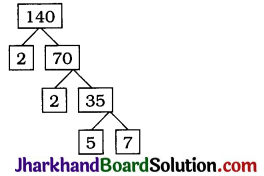
Thus, 140 = 2 × 2 × 5 × 7
= 22 × 5 × 7
2. Using factor tree method, we have

Thus, 156 = 2 × 2 × 3 × 13
= 22 × 3 × 13
3. Using factor tree method, we have
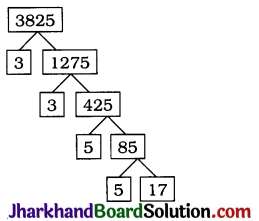
Thus, 3825 = 3 × 3 × 5 × 5 × 17
= 32 × 52 × 17
4. Using factor tree method, we have
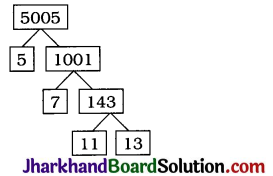
Thus, 5005 = 5 × 7 × 11 × 13
5. Using factor tree method, we have
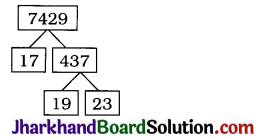
Thus, 7429 = 17 × 19 × 23
![]()
Question 2.
Find the LCM and HCF of the following pairs of integers and verify that LCM × HCF = product of the two numbers:
1. 26 and 91
2. 510 and 92
3. 336 and 54
Solution:
1. Using factor tree method, we have

∴ 26 = 2 × 13 and 91 = 7 × 13
Then, LCM (26, 91) = 2 × 7 × 13 = 182 and HCF (26, 91) = 13
Now, LCM × HCF = 182 × 13 = 2366 and 26 × 91 = 2366.
Hence, LCM × HCF = product of the two numbers.
2. Using factor tree method, we have
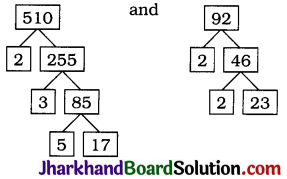
∴ 510 = 2 × 3 × 5 × 17 and
92 = 2 × 2 × 23 = 22 × 23
Then,
LCM (510, 92) = 22 × 3 × 5 × 17 × 23
= 23,460
and HCF (510, 92) = 2
Now, LCM × HCF = 23,460 × 2 = 46,920
and 510 × 92 = 46,920
Hence, LCM × HCF = product of the two numbers.
3. Using factor tree method, we have
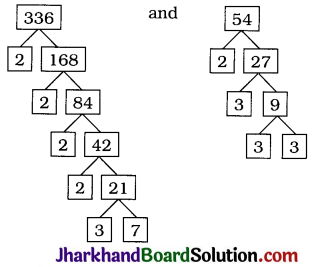
∴ 336 = 2 × 2 × 2 × 2 × 3 × 7
= 24 × 3 × 7 and
54 = 2 × 3 × 3 × 3 = 2 × 33
Then, LCM (336, 54) = 24 × 33 × 7 = 3024
and HCF (336, 54) = 2 × 3 = 6
Now, LCM × HCF = 3024 × 6 = 18,144 and
336 × 54 = 18,144.
Hence, LCM × HCF = product of the two numbers.
Question 3.
Find the LCM and HCF of the following integers by applying the prime factorisation method:
1. 12, 15 and 21
2. 17, 23 and 29
3. 8, 9 and 25
Solution:
1. Using factor tree method, we have
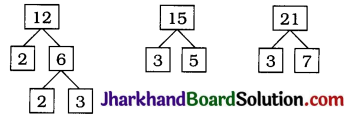
∴ 12 = 2 × 2 × 3 = 22 × 3, 15 = 3 × 5 and 21 = 3 × 7
Then,
LCM (12, 15, 21) = 22 × 3 × 5 × 7 = 420 and HCF (12, 15, 21) = 3.
2. 17 = 17 × 1, 23 = 23 × 1 and 29 = 29 × 1 as each of the given numbers is a prime.
Then, LCM (17, 23, 29) = 17 × 23 × 29
= 11,339
and HCF (17, 23, 29) = 1.
3. Using factor tree method, we have
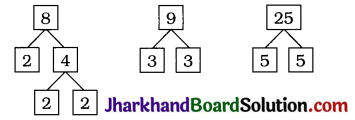
∴ 8 = 2 × 2 × 2 = 23, 9 = 3 × 3 = 32
and 25 = 5 × 5 = 52
Then, LCM (8, 9, 25) = 23 × 32 × 52
= 1800
and HCF (8, 9, 25) = 1.
![]()
Question 4.
Given that HCF (306, 657) = 9 find LCM (306, 657).
Solution:
We know, LCM (a, b) =

Taking a = 306 and b = 657, we get
LCM (306, 657) = \(\frac{306 \times 657}{\mathrm{HCF}(306,657)}\)
= \(\frac{306 \times 657}{9}\)
= 34 × 657
= 22,338
Thus, LCM (306, 657) = 22,338.
Question 5.
Check whether 6n can end with the digit 0 for any natural number n.
Solution:
If a number ends with digit 0, it would be divisible by 5 as well as 2. Hence, any number ending with digit 0, must have 2 and 5 both in its prime factorisation.
Now, 6n = (2 × 3)n = 2n × 3n for any natural number n. Thus, 6n has only two prime factors 2 and 3. So, the prime factorisation of 6n does not include 5 and hence 6n cannot end with digit 0 for any natural number n.
Question 6.
Explain why 7 × 11 × 13 + 13 and 7 × 6 × 5 × 4 × 3 × 2 × 1 + 5 are composite numbers.
Solution:
7 × 11 × 13 + 13 = 13 (7 × 11 + 1)
= 13 (77 + 1)
= 13 (78)
= 13 × 2 × 3 × 13
(∵ 78 = 2 × 3 × 13)
= 2 × 3 × 132
Thus, 7 × 11 × 13 + 13 can be expressed as a product of primes. Hence, 7 × 11 × 13 + 13 is a composite number.
7 × 6 × 5 × 4 × 3 × 2 × 1 + 5
= 5(7 × 6 × 4 × 3 × 2 × 1 + 1)
= 5 (1008 + 1)
= 5 × 1009
Thus, 7 × 6 × 5 × 4 × 3 × 2 × 1 + 5 can be expressed as a product of primes. Hence, 7 × 6 × 5 × 4 × 3 × 2 × 1 + 5 is a composite number.
![]()
Question 7.
There is a circular path around a sports field. Sonia takes 18 minutes to drive one round of the field, while Ravi takes 12 minutes for the same. Suppose they both start at the same point and at the same time, and go in the same direction. After how many minutes will they meet again at the starting point?
Solution:
Here, the LCM of the timings (in minutes) taken by Sonia and Ravi will answer the question satisfying all the conditions as mentioned in the question.
Now, 12 = 2 × 2 × 3 = 22 × 3 and
18 = 2 × 3 × 3 = 2 × 32.
Then, LCM (12, 18) = 22 × 32 = 36
Hence, after 36 minutes, Sonia and Ravi meet again at the starting point if they both start at the same point and at the same time and go in the same direction.